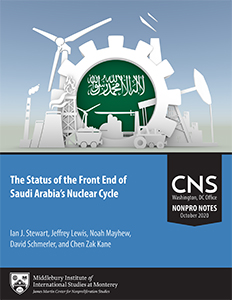October 7, 2020
Ian Stewart, Jeffrey Lewis, Noah Mayhew, David Schmerler, and Chen Zak Kane.
In recent weeks, several articles have appeared regarding possible developments in the Kingdom of Saudi Arabia’s (KSA) nuclear program. The Wall Street Journal published an article on August 4, 2020, reporting that “Western officials” believe a yellowcake facility (a uranium mill) had been constructed near the remote town of al-Ula in the country’s northwest. A few days later, the New York Times reported suspicions that a uranium conversion facility had been constructed at a site close to Riyadh. Finally, on September 17, the Guardian published an article detailing the results of joint Chinese–Saudi prospecting effort of the country that identified a large quantity of uranium reserves. Saudi Arabia has also constructed a facility, with Chinese assistance, to produce long-range solid-propellant ballistic missiles that could serve as a delivery system for a future nuclear force.
A research team at the James Martin Center for Nonproliferation Studies (CNS) analyzed each of these articles and has reviewed the underlying, unpublished reports. The purpose of this Nonpro Note is to capture the team’s findings and analysis up to the date of publication. The research team did not observe current mining activities at the four most promising deposits identified by the Sino-Saudi prospecting project. The research team has been unable to substantiate the claims of the existence of a uranium mill at al-Ula. Further, the absence of identifiable uranium mining at any of the four sites rated as “very good” by the prospecting project casts doubt on the existence of a mill at al-Ula, which is also located some distance from all the uranium deposits. The research team has not been able to prove or disprove the allegation that a uranium conversion facility has been constructed near Riyadh, but several observations cast some doubt on the existence of such a facility in the described location.
Saudi Arabia has, in recent years, sought and found large quantities of uranium reserves. While the KSA has detailed its civil nuclear plans, the country’s leadership has also stated that they will pursue nuclear weapons if Iran does. Saudi actions can therefore be understood as a longer-term hedge against a nuclear-armed Iran. In this context, insufficient safeguards on the KSA’s nuclear program should be a point of concern for all countries. International nuclear suppliers and assistance providers, including China, should not provide further support to the budding Saudi nuclear program until Saudi Arabia has taken steps to demonstrate its peaceful nature, including rescinding its Small Quantities Protocol (SQP) and concluding an additional protocol with the International Atomic Energy Agency (IAEA).
Download the report
The Status of the Front End of Saudi Arabia’s Nuclear Fuel Cycle
View more in the Nonpro Notes series
Keywords: Saudi Arabia, uranium mining, uranium milling, open-source analysis, nuclear fuel cycle, proliferation, safeguards, Additional Protocol, China, Middle East, Small Quantities Protocol, International Atomic Energy Agency

